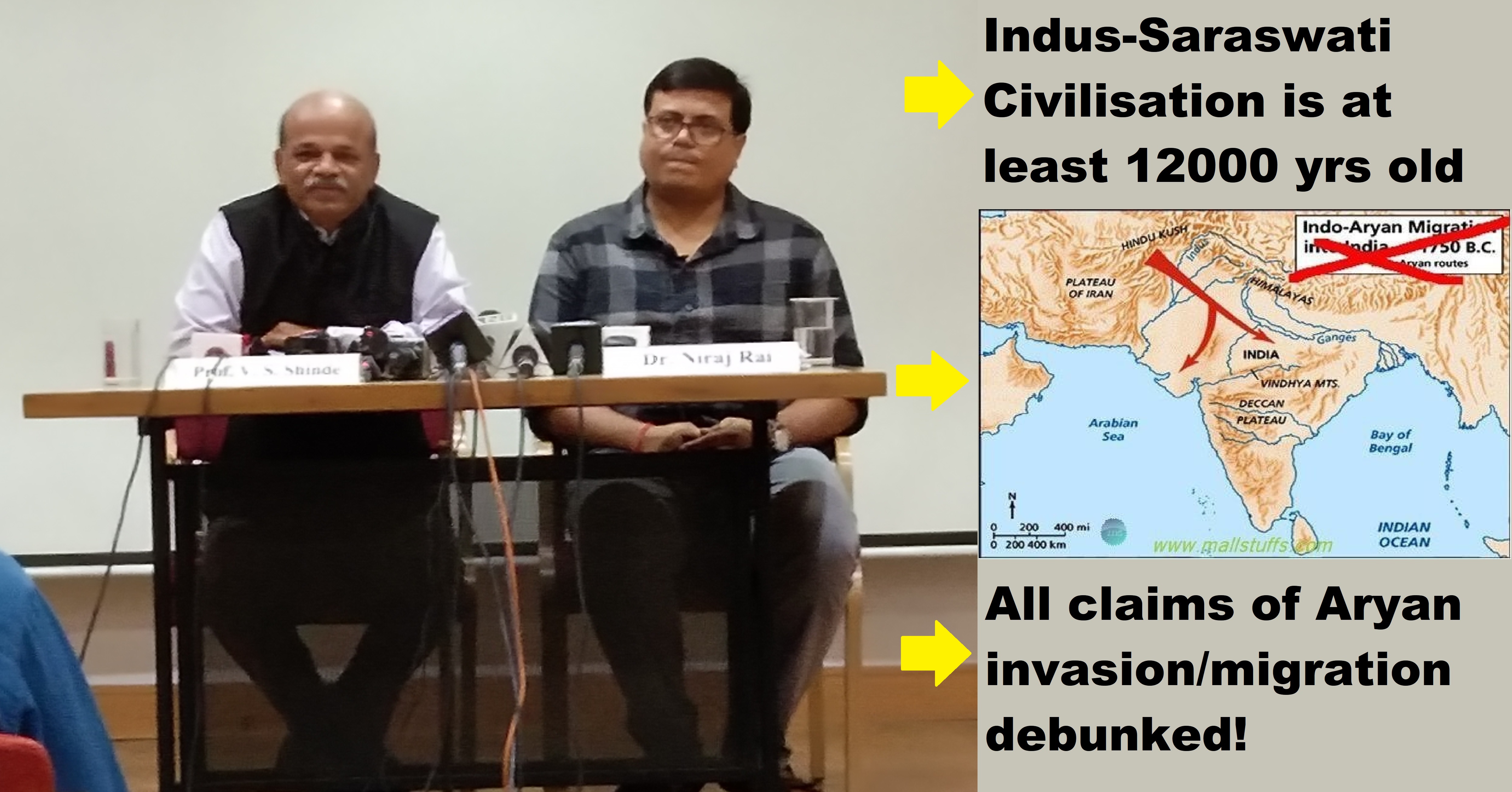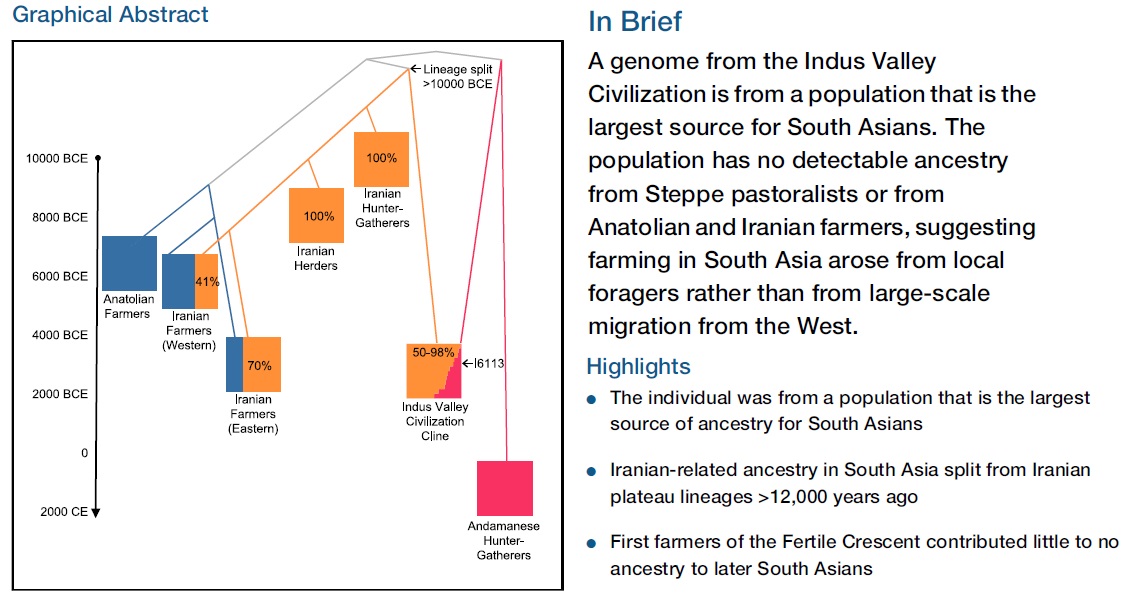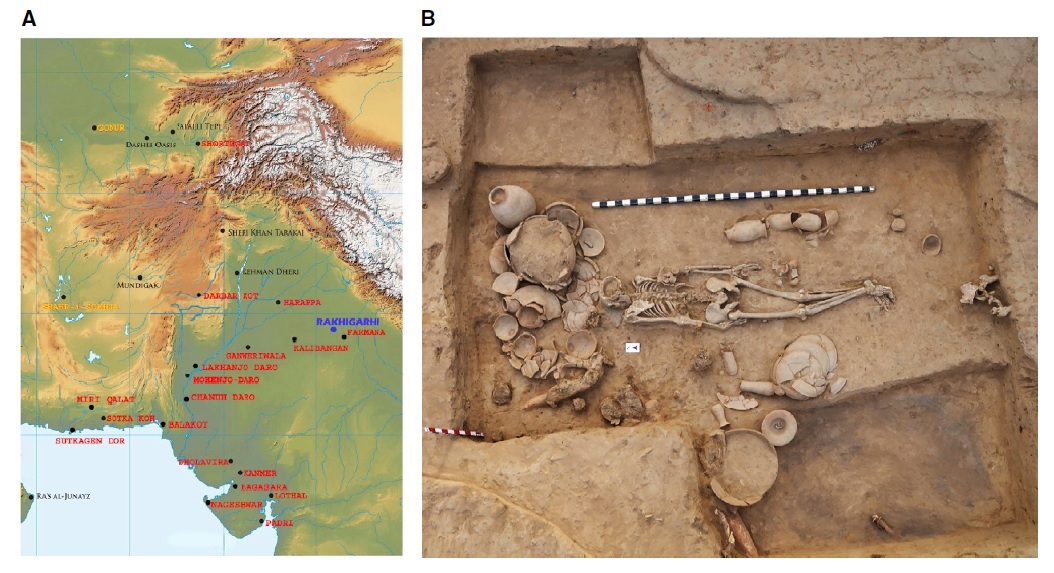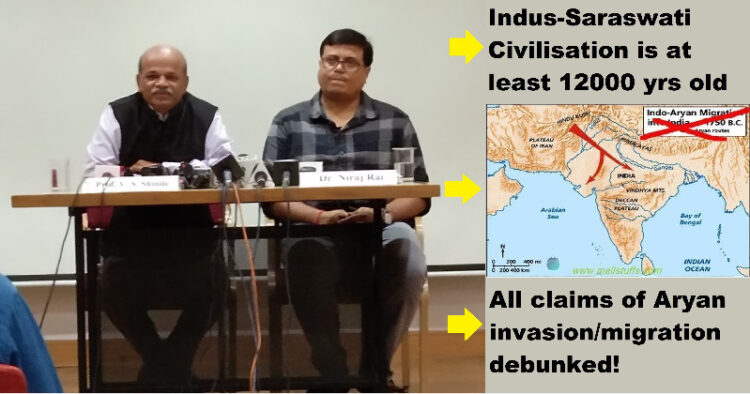Rakhigarhi reserach project finds that a genome from the Indus Valley Civilization is from a population that is the largest source for South Asians. The research authors also show that the population has no detectable ancestry from Steppe pastoralists or from Anatolian and Iranian farmers, suggesting that farming in South Asia arose from local foragers rather than from large-scale migration from the West.

Dr. Vasant Shinde, who led the team of excavators and Dr. Niraj Rai, formerly with CCMB, Hyderabad, addressing the press conference on the findings of the Rakhigarhi research project.
The already discredited Aryan Invasion Theory which later morphed into the Aryan Migration theory has now been dealt a huge body blow by the research findings at Rakhigarhi. The research team which made its findings public today, after they published a paper on the same in the ‘Cell’ magazine yesterday, corroborates the fact that every Indian genome descends from within the Subcontinent and also demolishes the pet theory of the Left and Evangelical historians who for decades tried to establish that ancient Indians (Aryans) came from the West of Harappa.
Today, their myth about the Aryan invasion or migration as they termed it later after invasion was disproved, stands demolished. The Archaeological excavations at Rakhigarhi were conducted jointly by Deccan College and the Department of Archaeology and Museums, Government of Haryana. Professor Vasant Shinde from the Post-Graduate and Research Institute of Deccan College led the team of excavators. Dr. Niraj Rai, then from the Centre for Cellular and Molecular Biology (CCMB) Hyderabad and Prof. David Reich from Harvard School of Medicine, Boston, USA led the team of Genetic scientists for ancient DNA studies.
Significance of Rakhigarhi Project

Rakhigarhi research project findings in brief (source: Cell Magazine)
Rakhigarhi in Hissar District of Haryana, is the largest city of the Harappan Civilization located almost in the middle of the Saraswati basin. Along with settlement, the Cemetery of the Harappans was also excavated and the remains from that were subjected to scientific research, including DNA studies. Though the site was under occupation from Early Harappan (5500 BCE-2600 BCE) to Mature Harappan (2600 BCE 1900 BCE), the cemetery belongs to the Mature (Urban) phase of the Harappan Culture dated from 2500-1900 BCE, based on material remains found in them.
In the paper published on 5th September, 2019 in the prestigious journal Cell, the authors Prof. Vasant Shinde, Vagheesh M. Narasimhan, Nadin Rohland, Nick Patterson, Niraj Rai, David Reich and others categorically state that “An Ancient Harappan Genome Lacks Ancestry from Steppe Pastoralists or Iranian Farmers”. First Ancient DNA from the Harappan Civilization city of Rakhigarhi links its People to Modern South Asians. This important research is of international significance as it will change the perspective of not only Indian History but also World History, especially the Aryan supremacist myth created by few German historians but used by the Evangelical Church and the Left academicians to discredit ancient Bharat. Mortimer Wheeler, one of the excavators of the site of Harappa in Pakistan had proposed that the Harappans were Dravidians and they were killed by the invading Aryans- these all were plausible hypotheses and myths prior to the ancient DNA findings. All such myths stand demolished today.
The ancient DNA results that have been made public today, completely reject the theory of Steppe pastoral or ancient Iranian farmers as source of ancestry to the Harappan population. This research also demolishes the hypothesis about mass human migration during Harappan time from outside the South Asia or even before. The hunter-gathers in South Asia have independent origin and they are the authors of the settled way of life in this part of the world. They do not contain any genome from either Steppe region or ancient Iranian farmers. The genetic continuity from hunter-gatherer to the modern times is visible in the DNA results. The same hunter-gatherer communities developed into agricultural communities around 7000 BCE and they are the authors of the Harappan Civilization that was founded in the middle of the third millennium BCE. The genetic identity remained the same throughout but the development in the material culture continued as an ongoing cultural process resulting into the transformation from hunter-gathers to the agriculture communities and from rural culture to urban civilization.
Aryan Migration/Invasion Theory demolished

A. Rakhigarhi archaeological site and other significant Harappan sites B. Skeletal remains at Rakhigarhi used for DNA analysis which formed the basis of the findgings (source: Cell Magazine)
This important breakthrough research completely sets aside the Aryan Migration/Invasion Theory. The skeletal remains found in the upper part of the Citadel area of Mohenjo daro belonged to those who died due to floods and not massacred by the Aryans as hypothesized by Sir Mortimer Wheeler. The Aryan Invasion Theory is based on very flimsy ground. This research also establishes the fact that the Vedic culture was developed by the indigenous people of South Asia. The authors in the press release state that “Our premise that the Harappans were the Vedic people thus has received strong corroborative scientific evidence based on ancient DNA studies.”
This research for the first time established the fact that the people of the Harappan Civilization are the ancestor of the most of the population of South Asia. For the first time this research indicates that there is a movement of the people from east to west. The Harppan people’s presence is evident at sites like Gonur in Turkmenistan and Sahr-i- Sokhta in Iran. As the Harappans traded with Mesompotamia, Egypt, Persian Gulf and almost all over South Asia, there is bound to be movement of the people resulting into a mixed genetic history. India had heterogeneous population right from the beginning of settled life and all of them have contributed to the development of this region.
The research findings also show that the idea of farming in South Asia did not come with the people from Middle East. It was developed by the indigenous people of South Asia. There is a hint that the South Asian ancient farmers began to move towards Middle East. Probably the idea of settled life and domestication went from South Asia to the Middle East and not the vice versa.
After the Dravidian theorists, few language chauvinists abetted by the Left historians in several Southern states were furthering this theory to de-link the culture, traditions and language of ancient Bharat from the states. They propagated the myth that the ‘Aryans’ invaded the Dravidians who were the ‘original’ inhabitants of the area around Harappa and drove them further south. Later when no archaeological or genetic data did not corroborate this claim, they then proposed the migration myth as per which the ancient Iranians from the West migrated to the Harappan region. Today, they all have to shut shop and try to unite people instead of dividing them based on false and agenda based theories.














Comments